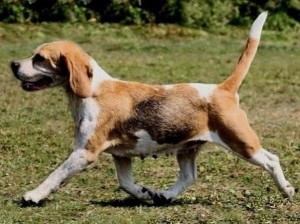The Importance of Breed-Specific Movement
Written by: Andrew Brace
To those who are not really steeped in the intricacies of our sport, it may well be that “good movement” is a question of the fastest moving dog with the waggiest tail, but we all know that there is more to an outstanding example of a purebred in the show ring than this.
Movement in the competitive environment is a demonstration of correct structure for THE BREED, and it also gives an indication of character and temperament.
Showing dogs at the highest level is not just a question of raising the leash and flying around a ring with a dog, regardless of breed; it is all about determining the best possible pace to demonstrate CORRECT.
Experienced and knowledgeable handlers are well aware of every nuance of their charge, both physically and mentally. When competing, they will know exactly what speed will show off their dog’s virtues to their best advantage. They will, of course, also be well versed in the detail of the appropriate breed standard and will understand what constitutes the breed-specific gait. This depth of knowledge and intimacy with the particular breed separates the great handlers from the masses.
It is always interesting to study handlers, either in reality or these days more often in video coverage, and watch how those involved with a variety of breeds adapt their handling style and speed to the dog they are showing. Some demonstrate an admirable level of versatility, whereas others opt for a more generic style of handling which can sometimes mask the very essence of a breed.
Speed is obviously relative to physical size, but even some large breeds need to be taken at a slower pace than others if they are to display typical. German Shepherd Dogs and Neapolitan Mastiffs should never be moved at the same speed if they demonstrate breed-specific gait, and gait is very much dictated by the original function
No Toy dogs, by definition physically the smallest of the groups, were bred to race around the ring, and some should be moved even more slowly than their competitors. Of course, a true master of the art is America’s David Fitzpatrick, whose expertise as a handler of Pekingese has no equal, in my opinion. Watching David demonstrate the dignified, self-possessed carriage of the breed is always an education, and I could only imagine David’s reaction if any judge was ever stupid enough to ask him to “speed up”!
In the breed ring, it is essential that dogs should be moved in such a way that they scream “typical” at the judge, sound but typical, and that does not always involve great speed. Some breeds of varying sizes will be required to display an element of elevation in their gait, a noticeable spring. In contrast, others were bred to adopt a lower carriage that covers the maximum ground with the minimum effort.
It can be interesting to watch different judging styles at breed level, and sometimes it appears that both handler and judge are of the opinion that the fastest dog will be first past the post! Not necessarily so.
Once the Best of Breed has been declared a handler, it has to consider the group situation, and it is always interesting to hear various handlers’ take on how they handle and move their dog in a group ring instead of the breed ring. Many talk of how they take advantage of the extra space where their dogs can “open up” more in a much larger ring. Some will say that their dogs consciously seem to “move up a gear” once they see available space. Others talk of how their dogs react differently when seeing other breeds at close quarters rather than just all of the same, and I’m sure there is an element of truth in all these claims.
Even though the group ring may be huge compared to the breed ring, there is no excuse for moving a dog in such a way that its carriage will drift away from what is typical for the breed. If dogs were meant to fly, they would have been born with wings! This is undoubtedly what the judge should be looking for at all times, and no judge wants to see a short-legged dog scuttling around the ring, trying desperately to keep up with its athletic handler.
The word “showmanship” seems to cover a multitude of sins within the fancy and is generally taken to mean an extrovert performance with a dog that is determined to win. Obviously, this kind of mentality comes more easily to some breeds than others, and those who have the attitude bred in them will so often nail a free stack – possibly unfairly – when compared to other breeds that are by nature more laid-back. To this end, it can sometimes be claimed that in the show ring, we reward temperament that may actually be untypical for a breed simply because it is more “showy”. Again speed mistakenly gets confused with showmanship, and so often, I have heard ringsiders claim that a dog is “showing better” when actually what they mean is that it is simply being moved faster.
Regardless of whether a dog is competing at breed level or in a variety situation, the overriding factor in a judge’s mind should be how good an example of ITS BREED is that particular dog up against the competition. A thorough knowledge of the Breed Standards is essential on the part of both judge and handler if dogs are to be evaluated efficiently, and at no point should speed be considered a deciding factor.
(The photograph I have used features a Beagle owned by Patricia Sutton, who demonstrates beautifully efficient and typical movement for the breed, coupled with correct proportions, head and tail carriage.)
Short URL: https://caninechronicle.com/?p=227511
Comments are closed













